Click on images to enlarge
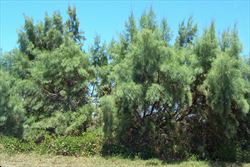
infestation (Photo: Forest and Kim Starr, USGS)
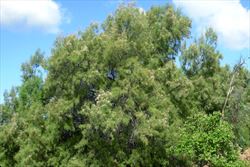
habit (Photo: Chris Gardiner)
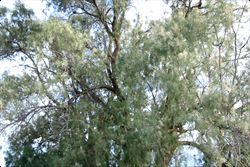
habit (Photo: Sheldon Navie)
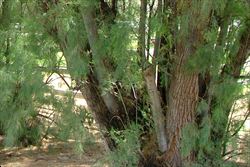
multi-stemmed trunk, with rough bark on older trunks and smooth bark on younger trunks (Photo: Sheldon Navie)
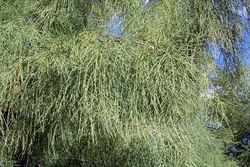
drooping green branchlets (Photo: Chris Gardiner)

brown branches and green branchlets (Photo: Sheldon Navie)
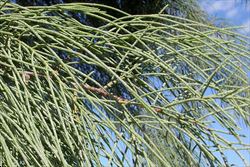
close-up of small branchlets (Photo: Chris Gardiner)
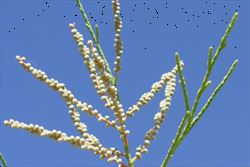
young flower clusters (Photo: Chris Gardiner)
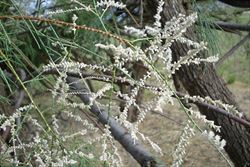
flower clusters (Photo: Sheldon Navie)
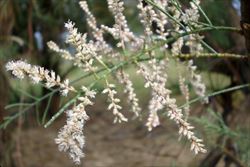
flower clusters (Photo: Sheldon Navie)
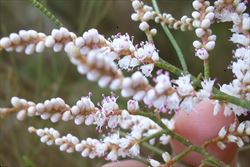
flowers (Photo: Forest and Kim Starr, USGS)
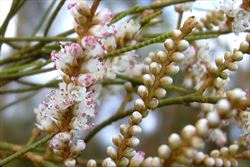
close-up of flowers and flower buds (Photo: Forest and Kim Starr, USGS)
Scientific Name
Tamarix aphylla (L.) Karst.
Synonyms
Thuja aphylla L.
Family
Tamaricaceae
Common Names
athel, athel pine, athel tamarisk, athel tamarix, athel tree, desert tamarisk, flowering cypress, salt cedar, tamarisk
Origin
Native to northern and eastern Africa, the middle-east, south-western Asia and the Indian sub-continent.
Cultivation
Widely cultivated as a garden ornamental and street tree, and particularly common in inland areas.
Naturalised Distribution
Widely naturalised, but scattered, mainly in the drier inland parts of Australia (i.e. in the southern and central parts of the Northern Territory, in western Queensland and north-western New South Wales, in many parts of South Australia and in some parts of Western Australia). Also occasionally naturalised in eastern Queensland and possibly also naturalised in other inland districts of New South Wales.
Habitat
A weed of in semi-arid, arid, sub-tropical and warmer temperate regions. It is particularly common along inland waterways, but is occasionally also a weed of open woodlands, grasslands, pastures and roadsides.
Habit
A small or medium-sized spreading tree that can reach up to 10-12 m in height.
Distinguishing Features
- a spreading tree with rough and deeply furrowed bark that is dark grey or greyish-brown.
- its younger stems are smooth, jointed, and have a bluish-green or greyish-green appearance.
- its leaves are reduced to tiny scales (1-2 mm long) and are alternately arranged along the fine branchlets.
- its small flowers (with petals about 2 mm long) are stalkless, pale pink or whitish in colour.
- they are borne in elongated clusters (3-6 cm long) near the tips of the branches.
- its small bell-shaped capsules (2-3 mm long) contain numerous minute seeds that are topped with a tuft of tiny hairs.
Stems and Leaves
This species is often multi-stemmed and produces a spreading crown of many stout branches and long, drooping, jointed twigs. The older bark on the main trunk is dark grey or greyish-brown, rough, and furrowed into long narrow ridges. Younger stems are smooth, jointed, and have a bluish-green or greyish-green appearance. As these branches mature they turn brown and then greyish in colour.
The leaves are reduced to tiny scales (1-2 mm long) and are alternately arranged along the fine branchlets (which are often mistaken for cylindrical leaves and are similar in appearance to pine needles). These 'leaves' are bluish-green (i.e. glaucous) or a dull greyish-green colour.
Flowers and Fruit
Large numbers of small, pale pink or whitish coloured flowers are produced along the tips of the branches. Separate male and female flowers are borne on the same plant (i.e. this species is monoecious). These flowers are stalkless (i.e. sessile) and borne in elongated clusters (i.e. racemes) 3-6 cm long. They have five sepals and five petals (about 2 mm long), and the male flowers have five stamens. Flowering occurs mostly during summer.
The small fruit are bell-shaped capsules (2-3 mm long) containing numerous minute seeds. Each of these seeds is topped with a tuft of tiny hairs (most of the seeds are usually sterile).
Reproduction and Dispersal
This plant reproduces by seeds that are dispersed by wind, flood waters and animals. It may also spread via suckering and the rooting of buried or submerged stem segments that have broken from the tree and been carried significant distances by flood waters.
Environmental Impact
Athel pine (Tamarix aphylla) is regarded as a significant environmental weed in the Northern Territory, South Australia and Western Australia and is actively managed by community groups in the Northern Territory and Western Australia. It is also regarded as a potentially significant environmental weed in other parts of Australia, and is one of the twenty Weeds of National Significance (WoNS) in Australia.
Legislation
This species is declared under legislation in the following states and territories:
- ACT: C4 - prohibited pest plant (a pest plant whose propagation and supply is prohibited).
- New South Wales: Class 5 - a restricted weed which must not be sold, bought or knowingly distributed (throughout the entire state).
- Northern Territory: B - growth and spread to be controlled (in the Alice Springs region, outside of town only), and C - not to be introduced into the Territory.
- Queensland: Class 3 - this species is primarily an environmental weed and a pest control notice may be issued for land that is, or is adjacent to, an environmentally significant area (throughout the entire state). It is also illegal to sell a declared plant or its seed in this state.
- South Australia: 11+ - Class 11 is a category for those species that are 'Weeds of National Significance' but not otherwise declared in the state. Control of this species is not currently required in the state, however its sale is prohibited.
- Tasmania: D - the importation or sale of this species is prohibited and measures to reduce its population in an area, eradicate it from an area, or restrict it to a particular area may be required.
- Victoria: R - a restricted weed that cannot be sold or traded in this state.
- Western Australia: P1 - trade, sale or movement into the state prevented (throughout the entire state).
Management
For information on the management of this species see the following resources:
- the National Weeds Strategy Strategic Plan for this species, which is available online at http://www.weeds.org.au/docs/apstrat.pdf.
- the Northern Territory Department of Natural Resources, Environment and The Arts Agnote on this species, which is available online at http://www.nt.gov.au/weeds.
Similar Species
Athel pine (Tamarix aphylla) is very similar to salt cedar (Tamarix ramosissima) and small-flowered tamarisk (Tamarix parviflora). These three species can be distinguished by the following differences:
- athel pine (Tamarix aphylla) is a small to medium-sized evergreen tree (up to 12 m or more tall). Its flowers have five white to pale pink petals.
- salt cedar (Tamarix ramosissima) is a large shrub or small semi-deciduous or deciduous tree (less than 5 m tall) that has tiny leaves that are stalkless. Its flowers have five pink to purple petals.
- small-flowered tamarisk (Tamarix parviflora) is a large shrub or small semi-deciduous or deciduous tree (less than 6 m tall) that has tiny leaves that are stalkless. Its flowers have four pink to purple petals.
Athel pine (Tamarix aphylla) has a similar appearance to the native she-oaks (Casuarina spp. and Allocasuarina spp.). However, athel pine (Tamarix aphylla) can be distinguished from these native plants by its fruit and close inspection of the scale leaves on the fine branchlets. The scale leaves of the native she-oaks (Casuarina spp. and Allocasuarina spp.) are arranged in whorls around the branchlets, while those of athel pine (Tamarix aphylla) are alternately arranged along the branchlets. Also, the native she-oaks (Casuarina spp. and Allocasuarina spp.) produce hard, woody fruit that resemble small pine cones.

